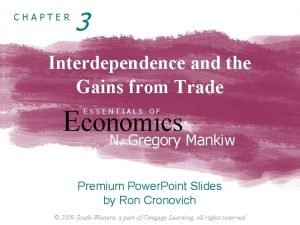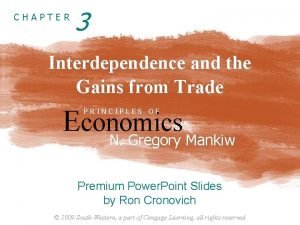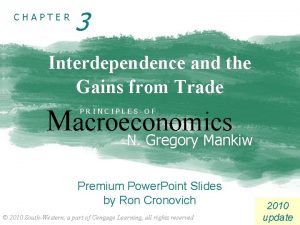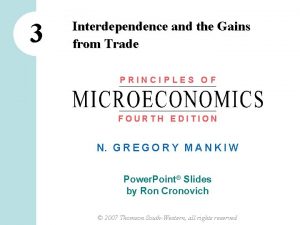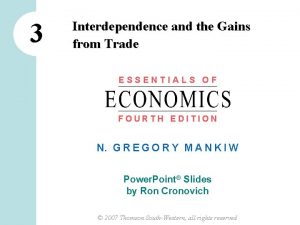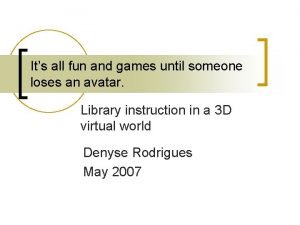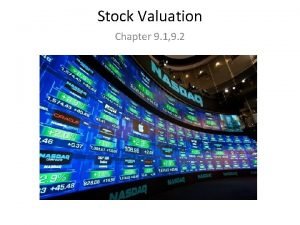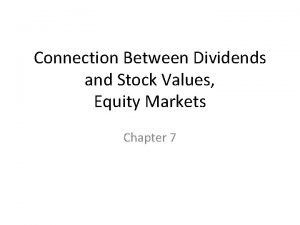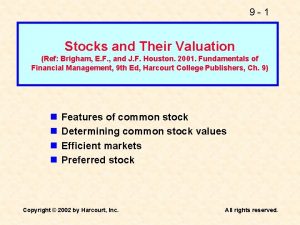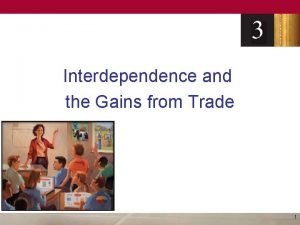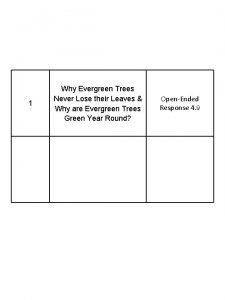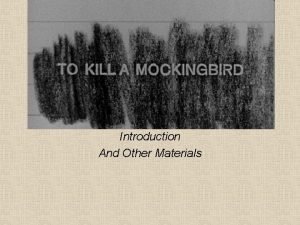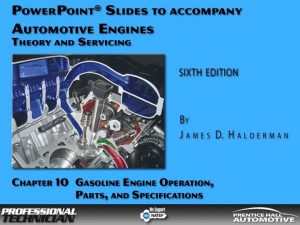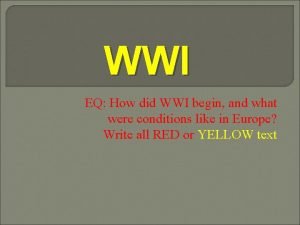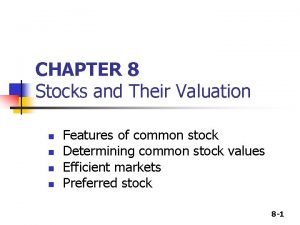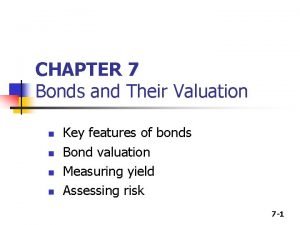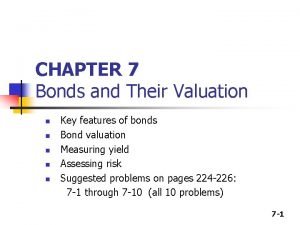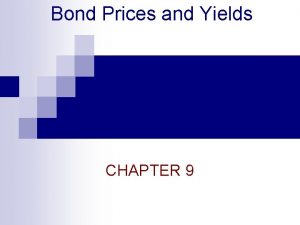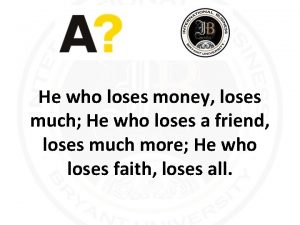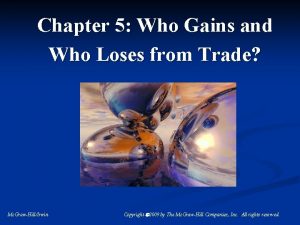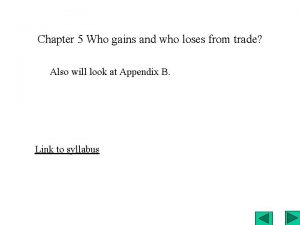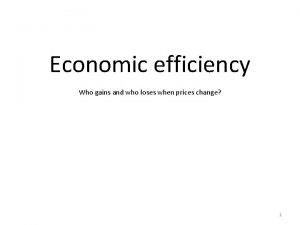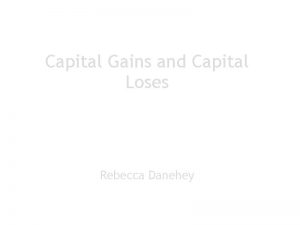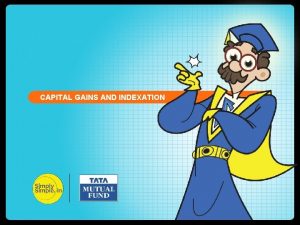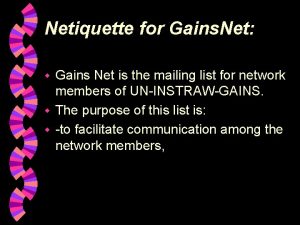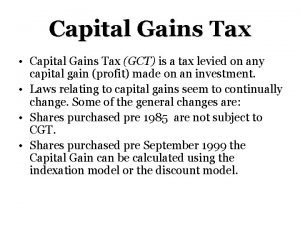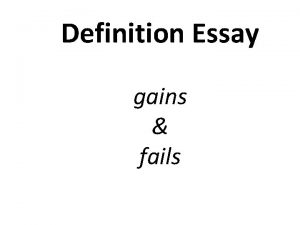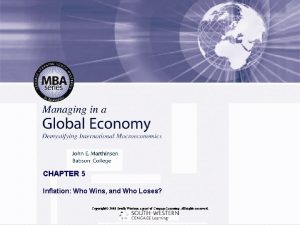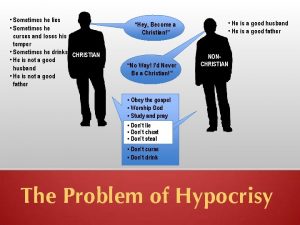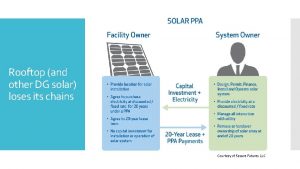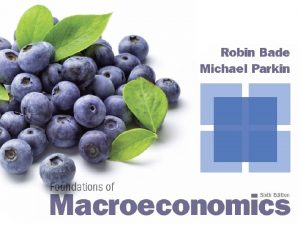Chapter Five Who Gains and Who Loses from
























- Slides: 24

Chapter Five Who Gains and Who Loses from Trade?

Short-Run Effects of Opening Trade In the short run, with factors of production tied to their current lines of production, gains and losses are divided by output sector. All factors tied to the rising sector gain, and all factors tied to the declining sector lose. In the U. S. , owners of land labor in the wheat sector are expected to gain, and owners of land labor in the cloth sector are expected to lose. ©Mc. Graw-Hill Education

The Long-Run Factor-Price Response In the long run, factors can move between sectors in response to differences in returns. In the long run, wage rates end up lower for all U. S. workers and higher for all foreign workers (each relative to its level with no trade). All land rents end up higher in the U. S. and lower in the Rest of the World (each relative to its level with no trade). Why? ©Mc. Graw-Hill Education

How Free Trade Affects Income Distribution in the Long Run ©Mc. Graw-Hill Education

How Free Trade Affects Income Distribution in the Long Run Long Description 1 The first row of the matrix describes initial product prices in both the United States and the Rest of the World before trade. Initially, wheat is cheap and cloth is expensive in the United States. Wheat is expensive and cloth is cheap In the Rest of the World. Row 2 diagrams the opening of trade. The United States sells wheat to, and purchases cloth from, the Rest of the World. The Rest of the World sells cloth to, and purchases wheat from, the United States. Row 3 describes the subsequent changes in product prices in both countries after the opening of trade. In the United States the price of wheat rises and the price of cloth falls. In the Rest of the World the price of wheat falls and the price of cloth rises. ©Mc. Graw-Hill Education

How Free Trade Affects Income Distribution in the Long Run Long Description 2 Row 4 describes the change in production as producers respond to changes in factor prices. In response to product price changes, the United States produces more wheat and less cloth. The Rest of the World produces less wheat and more cloth. Row 5 describes national factor markets changing as a crucial step. In the United States, for each unit of cloth sacrificed, many workers and a small amount of land is laid off, as extra wheat demands few workers and much land. In the Rest of the World, for each unit of wheat sacrificed, much land few workers are laid off, as extra cloth demands many workers and little land. ©Mc. Graw-Hill Education

How Free Trade Affects Income Distribution in the Long Run Long Description 3 Row 6 describes the response of national factor prices to the changes in the national factor markets. In the United States wage rates fall and rents rise in both sectors. In the Rest of the World wage rates rise and rents fall in both sectors. Row 7 describes the long run results. In the long run, product prices equalize between countries. There are net gains for both countries, but different effects on different groups. The winners are United States landowners and foreign workers. The losers are United States workers and foreign landowners. ©Mc. Graw-Hill Education

Three Implications of the Heckscher-Ohlin Model 1. The Stolper-Samuelson theorem 2. The specialized-factor pattern 3. The factor-price equalization theorem ©Mc. Graw-Hill Education

The Stolper-Samuelson Theorem states that, given certain conditions and assumptions, including full adjustment to a new long-run equilibrium, an event that changes relative product prices in a country unambiguously has two effects: 1. It raises the real return to the factor used intensively in the rising-price industry. 2. It lowers the real return to the factor used intensively in the falling-price industry. ©Mc. Graw-Hill Education

A Factor-Ratio Paradox • The effects of trade on factor use have their paradoxical side. • The same fixed amounts of factor supplies get reemployed in the long run. • But everything else about factor use changes. ©Mc. Graw-Hill Education

The Specialized-Factor Pattern The more a factor is specialized and concentrated in the production of a product whose relative price is rising, the more this factor stands to gain. The more a factor is specialized and concentrated in the production of a product whose relative price is falling, the more it stands to lose from the change in product price. ©Mc. Graw-Hill Education

The Factor-Price Equalization Theorem 1 This theorem states that, given certain conditions and assumptions, free trade equalizes not only product prices but also the prices of individual factors between the two countries. To see what this means, consider our standard example of free trade in cloth and wheat. The theorem predicts that, even if factors cannot migrate between countries directly, with free trade: • Laborers (of the same skill level) earn the same wage rate in both countries. • Units of land (of comparable quality) earn the same rental return in both countries. ©Mc. Graw-Hill Education

The Factor-Price Equalization Theorem 2 The factor-price equalization theorem implies that laborers will end up earning the same wage rate in all countries, even if labor migration between countries is not allowed. Trade makes this possible, within the assumptions of the model, because the factors that cannot migrate between countries end up being implicitly shipped between countries in commodity form. ©Mc. Graw-Hill Education

Does Heckscher-Ohlin Explain Actual Trade Patterns? 1 The Heckscher-Ohlin approach to trade provides important insights, in theory, about the gains from trade, the effects of trade on production and consumption, and the effects of trade on the incomes of production factors. These insights are based on the hunch by Heckscher and Ohlin about the basis for trade —why countries export some products and import others. ©Mc. Graw-Hill Education

Does Heckscher-Ohlin Explain Actual Trade Patterns? 2 The first formal efforts to test the H-O theory used the simple model of two factors of production and U. S. trade data. These tests failed to confirm the H-O theory. More recent tests recognize that more than two types of production factors are relevant to the H-O explanation of trade patterns. ©Mc. Graw-Hill Education

Does Heckscher-Ohlin Explain Actual Trade Patterns? 3 Economists have tested the H-O theory in several ways. Complete tests require information on: • The factor endowments of different countries. • International trade for various products. • The factor proportions used in producing these products. ©Mc. Graw-Hill Education

What Are the Export-Oriented and Import -Competing Factors? 1 ©Mc. Graw-Hill Education

What Are the Export-Oriented and Import -Competing Factors? Long Description 1 A schematic provides a side by side comparison of the factor content of each 1 million dollars of United States exports and the factor content of each 1 million dollars of imports competing with domestic imports. Unskilled labor comprises a relatively smaller proportion of United States exports than United States imports. Skilled labor comprises a larger proportion of exports than the skilled labor content of imports. Capital, such as plant, equipment, and inventories, content is relatively larger in imports than in exports. Farmland rents comprise a larger proportion of exports than imports and mineral rights comprise a smaller proportion of exports than imports. ©Mc. Graw-Hill Education

What are the Export-Oriented and Import. Oriented Factors? 2 ©Mc. Graw-Hill Education

What Are the Export-Oriented and Import -Competing Factors? Long Description 2 A schematic provides a side by side comparison of the factor content of each 1 million dollars of Canadian exports and the factor content of each 1 million dollars of imports competing with domestic imports. Unskilled labor comprises a relatively smaller proportion of Canadian exports than Canadian imports. Skilled labor comprises a smaller proportion of exports than the skilled labor content of imports. Capital, such as plant, equipment, and inventories, content is relatively smaller in imports than in exports. Farmland forests, as well as mineral rights, comprise a larger proportion of exports than competing imports. ©Mc. Graw-Hill Education

Do Factor Prices Equalize Internationally? Factor prices clearly are not fully equalized across countries. The factor-price equalization theorem is based on a number of assumptions, and some of these do not hold up in the real world. A weaker form of theorem works better: International trade tends to make the prices of factor more similar across countries. • For example, the rapid increase in real wages for factory workers in China ©Mc. Graw-Hill Education

China’s Exports and Imports 1 One of the most striking features of the global economy is the rise of China as a trading force after it opened to international trade beginning in the 1970 s. China accounted for less than 1 percent of international trade in 1980. Its exports and imports have grown rapidly, so that by 2014 China’s trade was about 10 percent of world trade. ©Mc. Graw-Hill Education

China’s Exports and Imports 2 1. First, its trade has been roughly balanced— the value of exports has roughly equaled the value of imports, even though both are growing rapidly. 2. Second, much of its pattern of net exports and net imports of different products is just what Heckscher and Ohlin would predict. ©Mc. Graw-Hill Education

China: Value of Exports and Value of Imports, 1976 -2016 ©Mc. Graw-Hill Education
 Chapter 3 interdependence and the gains from trade summary
Chapter 3 interdependence and the gains from trade summary Chapter 3 interdependence and the gains from trade answers
Chapter 3 interdependence and the gains from trade answers Chapter 3 interdependence and the gains from trade answers
Chapter 3 interdependence and the gains from trade answers Interdependence and the gains from trade chapter 3
Interdependence and the gains from trade chapter 3 Chapter 3 interdependence and the gains from trade summary
Chapter 3 interdependence and the gains from trade summary Interdependence and the gains from trade
Interdependence and the gains from trade It's all fun and games until someone loses an i
It's all fun and games until someone loses an i Dividend yield and capital gains yield
Dividend yield and capital gains yield Non constant growth model
Non constant growth model Dividend yield and capital gains yield
Dividend yield and capital gains yield Cephalocaudal and proximodistal pattern diagram
Cephalocaudal and proximodistal pattern diagram Interdependence and the gains from trade
Interdependence and the gains from trade 5 senses and 5 elements
5 senses and 5 elements Why does percy leave grover at the bus station
Why does percy leave grover at the bus station Genesis 27:1-36
Genesis 27:1-36 Why the evergreen trees never lose their leaves story
Why the evergreen trees never lose their leaves story What will happen if tom robinson loses his last appeal?
What will happen if tom robinson loses his last appeal? A normally aspirated automobile engine loses about
A normally aspirated automobile engine loses about How did wwi begin?
How did wwi begin? Fsa scale scores learning gains 2021
Fsa scale scores learning gains 2021 Italian gains in ww1
Italian gains in ww1 Capital gain yield
Capital gain yield Junk bond ratings
Junk bond ratings Current yield ytm
Current yield ytm Expected capital gains yield formula
Expected capital gains yield formula
